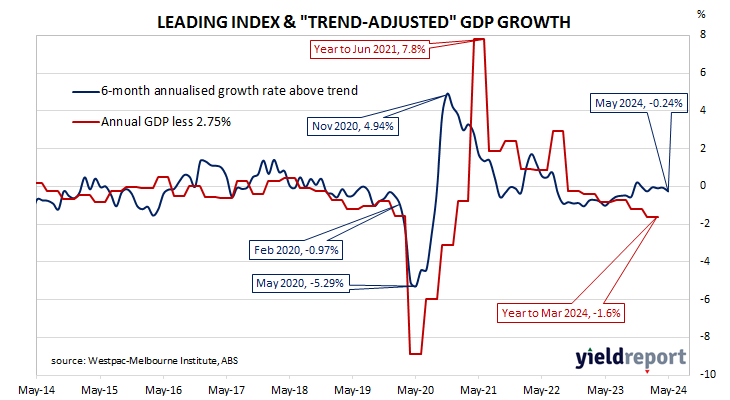Summary: Leading index growth rate up in June; Westpac: lacklustre growth momentum continuing; reading implies annual GDP growth of around 2.25%-2.50%; ACGB yields steady; rate-rise expectations soften; main movements over past six months are significantly weaker commodity prices, stabilisation of monthly hours worked.
Westpac and the Melbourne Institute describe their Leading Index as a composite measure which attempts to estimate the likely pace of Australian economic growth in the short-term. After reaching a peak in early 2018, the index trended lower through 2018 and 2019 before plunging to recessionary levels in the second quarter of 2020. Subsequent readings spiked towards the end of 2020 but then trended lower through 2021 and 2022 before flattening out in 2023 and 2024.
June’s reading has now been released and the six month annualised growth rate of the indicator registered -0.13%, up from May’s revised figure of -0.28%. The index reading represents a rate relative to “trend” GDP growth, which is generally thought to be around 2.50% to 2.75% per annum in Australia.
“Despite a marginally improved read in June, the Leading Index growth rate remains subdued, pointing to lacklustre growth momentum continuing through the second half of 2024 and into early 2025,” said Westpac senior economist Matthew Hassan.
Westpac states the index leads GDP growth by “three to nine months into the future” but the highest correlation between the index and actual GDP figures occurs with a three-month lead. The current reading may therefore be considered to be indicative of an annual GDP growth rate of around 2.25% to 2.50% in the next quarter
Domestic Treasury bond yields remained stable on the day. By the close of business, 3-year, 10-year and 20-year ACGB yields had all returned to their starting points at 3.93%, 4.26% and 4.60% respectively.
Expectations regarding rate rises in the next twelve months softened slightly. Cash futures prices at the end of the day implied the cash rate has some chance of rising above the current rate of 4.34% in the short-term, with an average of 4.37% in August and 4.385% in November. However, February 2025 contracts implied 4.31% and May 2025 contracts implied 4.16%, 18bps less than the current cash rate.
“The Leading Index growth rate has slipped back a little over the first half of 2024, moving from –0.05% in December to the current –0.13%,” Hassan added. “The main component moves over this period have been a significant weakening in commodity prices and a stabilisation in monthly hours worked, the former taking 0.31 percentage points off the Index growth rate and the latter adding 0.22 percentage points.”
Westpac is currently forecasting GDP growth to be 1.6% in calendar 2024, rising to 2.3% in calendar 2025. The RBA’s May Statement on Monetary Policy also forecasts GDP growth for the years ending December 2024 and December 2025 to be 1.6% and 2.3% respectively.


